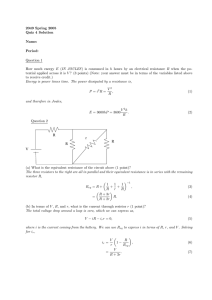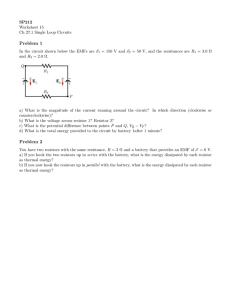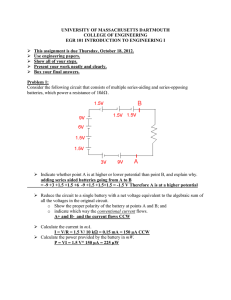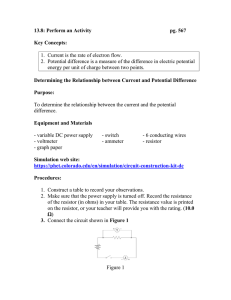Version 001 – CIRCUITS – holland – (1290)
advertisement
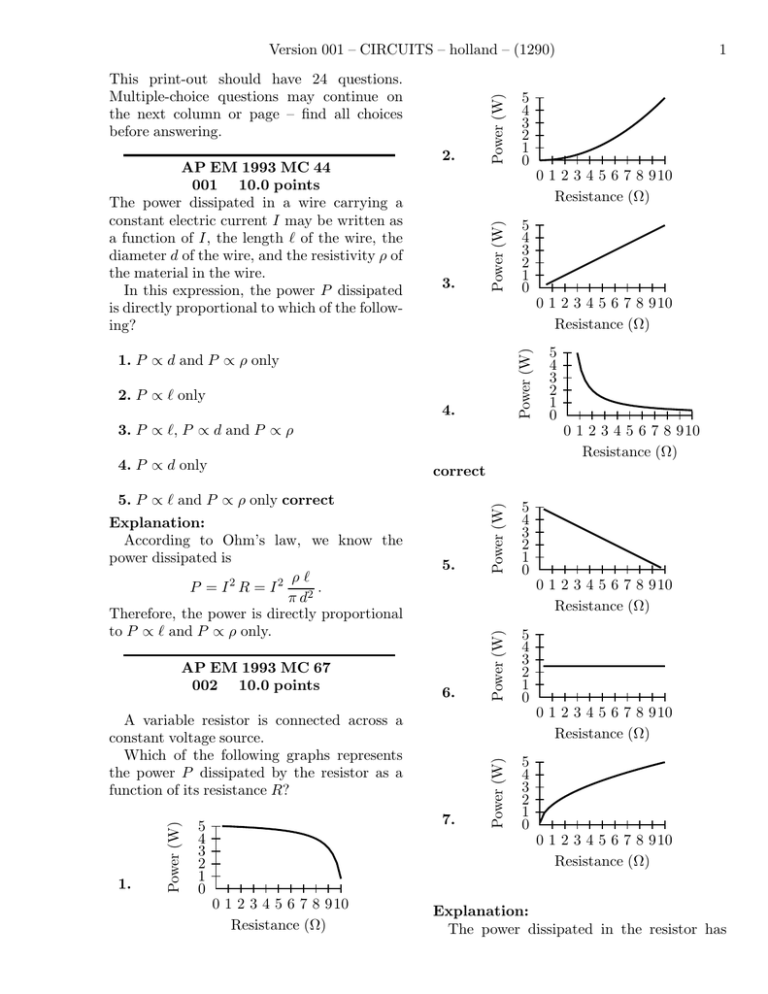
This print-out should have 24 questions. Multiple-choice questions may continue on the next column or page – find all choices before answering. 2. 3. 5 4 3 2 1 0 5 4 3 2 1 0 Power (W) 0 1 2 3 4 5 6 7 8 910 Resistance (Ω) 1. P ∝ d and P ∝ ρ only 2. P ∝ ℓ only 4. 3. P ∝ ℓ, P ∝ d and P ∝ ρ 4. P ∝ d only Power (W) 6. 5 4 3 2 1 0 0 1 2 3 4 5 6 7 8 910 Resistance (Ω) A variable resistor is connected across a constant voltage source. Which of the following graphs represents the power P dissipated by the resistor as a function of its resistance R? 7. 5 4 3 2 1 0 5 4 3 2 1 0 0 1 2 3 4 5 6 7 8 910 Resistance (Ω) Power (W) AP EM 1993 MC 67 002 10.0 points 5. Power (W) correct Explanation: According to Ohm’s law, we know the power dissipated is ρℓ P = I2 R = I2 . π d2 Therefore, the power is directly proportional to P ∝ ℓ and P ∝ ρ only. Power (W) 5 4 3 2 1 0 0 1 2 3 4 5 6 7 8 910 Resistance (Ω) 5. P ∝ ℓ and P ∝ ρ only correct 1. 1 0 1 2 3 4 5 6 7 8 910 Resistance (Ω) Power (W) AP EM 1993 MC 44 001 10.0 points The power dissipated in a wire carrying a constant electric current I may be written as a function of I, the length ℓ of the wire, the diameter d of the wire, and the resistivity ρ of the material in the wire. In this expression, the power P dissipated is directly proportional to which of the following? Power (W) Version 001 – CIRCUITS – holland – (1290) 5 4 3 2 1 0 0 1 2 3 4 5 6 7 8 910 Resistance (Ω) 0 1 2 3 4 5 6 7 8 910 Resistance (Ω) Explanation: The power dissipated in the resistor has Version 001 – CIRCUITS – holland – (1290) 2 several expressions E2 = I2 R , R where the last two are simply derived from the first equation together with the application of the Ohm’s law. Since the resistor is connected to a constant voltage source E = constant AP B 1993 MC 20 22 004 (part 1 of 3) 10.0 points P =EI = E2 constant = , R R tells us that the power is inversely propor 1 . tional to the resistance P ∝ R A battery with an internal resistance is connected to two resistors in series. 16 Ω 20 Ω Power (W) X 4Ω internal resistance Y What is the emf E of the battery? 1. E = 10.8 V 5 4 3 2 1 0 2. E = 12.0 V correct 0 1 2 3 4 5 6 7 8 910 Resistance (Ω) AP EM 1998 MC 42 003 10.0 points A wire of resistance R dissipates power P when a current I passes through it. The wire is replaced by another wire with resistance 3 R. The power P ′ dissipated by the new wire when the same current passed through it is 3. E = 13.2 V 4. E = 1.2 V 5. E = 6.0 V Explanation: Let : 1. P ′ = 3 P . correct R1 R2 r I = 16 Ω , = 20 Ω , = 4 Ω , and = 0.3 A . R1 2. P ′ = 6 P . P . 3 P 4. P ′ = . 9 3. P ′ = I X R2 E r internal resistance The total resistance of the circuit is 5. P ′ = P . Explanation: The power dissipated by a resistor is given by P = I2 R . So if we change R to 3 R, the power dissipated will be changed correspondingly to ′ E 0.3 A P = 2 ′ 2 P = I (R ) = I (3 R) = 3 P . Rtotal = r + R1 + R2 = 4 Ω + 16 Ω + 20 Ω = 40 Ω , so the emf of the battery is E = I Rtotal = (0.3 A) (40 Ω) = 12 V . Y Version 001 – CIRCUITS – holland – (1290) 005 (part 2 of 3) 10.0 points What is the potential difference across the terminals Y and X of the battery? 1. VY X = 10.8 V correct 3 AP EM 1993 MC 57 58 007 (part 1 of 2) 10.0 points The switch has been open for a long period of time. R2 2. VY X = 12.0 V C 3. VY X = 1.2 V 4. VY X = 6.0 V R1 V S 5. VY X = 13.2 V Explanation: The potential difference across the terminals of the battery is VY X = E − I r = 12 V − (0.3 A) (4 Ω) = 10.8 V , or VY X = VXY = I (R1 + R2 ) = (0.3 A)(16 Ω + 20 Ω) = 10.8 V . 006 (part 3 of 3) 10.0 points What power Pinternal is dissipated by the 4 Ω internal resistance of the battery? 1. Pinternal = 1.2 W 2. Pinternal = 4.8 W 3. Pinternal = 0.36 W correct 4. Pinternal = 3.2 W 5. Pinternal = 3.6 W Explanation: The power dissipated by the r = 4 Ω internal resistance is Pinternal = I 2 r = (0.3 A)2 (4 Ω) = 0.36 W . Immediately after the switch is closed, the current supplied by the battery is V . R2 V (R1 + R2 ) 2. I0 = . R1 R2 V . correct 3. I0 = R1 1. I0 = 4. I0 = 0 . 5. I0 = V . R1 + R2 Explanation: Before the switch is closed, there is no charge on the capacitor, so the voltage is zero across the capacitor at this time. Because it is not possible to change the charge on the capacitor like a step function (or the current should be infinitely large), immediately after the switch is closed, the voltage across the capacitor (and R2 ) is still zero. Therefore, the voltage across R1 is V ; i.e., think of the capacitor as being a short-circuit for this instant of time. So the current supplied by the battery, which is the same as the current going through V R1 , is I0 = . R1 008 (part 2 of 2) 10.0 points A long time after the switch has been closed, the current I∞ supplied by the battery is Version 001 – CIRCUITS – holland – (1290) V . R2 4. |EC | = 13 V 2. I∞ = 0 . 5. |EC | = 24 V V . correct R1 + R2 V . 4. I∞ = R1 V (R1 + R2 ) . 5. I∞ = R1 R2 Explanation: After a long time, the capacitor has been charged and remained stable. That means the current going through R1 is the same as the current going through R2 ; i.e., think of the capacitor as being a open-circuit for this time. So we can write down the equation 3. I∞ = 6. |EC | = 28 V 7. |EC | = 5 V 8. |EC | = 4 V 9. |EC | = 18 V 10. |EC | = 9 V correct Explanation: t a It R3 V = I∞ R 1 + I∞ R 2 , which gives the current I∞ as I∞ = E b 7Ω 16 µF S V . R1 + R2 The circuit has been connected as shown in the figure for a “long” time. 24 V R4 Ib AP EM 1993 MC 71 009 (part 1 of 2) 10.0 points 1Ω b It Ib Let : 5Ω R2 R1 C 1. I∞ = 4 = 5 Ω, = 7 Ω, = 1 Ω, = 23 Ω , and = 16 µF . After a “long time” implies that the capacitor C is fully charged and therefore the capacitor acts as an open circuit with no current flowing to it. The equivalent circuit is 23 Ω It It a R1 R3 S What is the magnitude of the electric potential EC across the capacitor? R1 R2 R3 R4 C Ib R2 b R4 Ib 1. |EC | = 33 V Rt = R1 + R2 = 5 Ω + 7 Ω = 12 Ω 2. |EC | = 17 V Rb = R3 + R4 = 1 Ω + 23 Ω = 24 Ω E 24 V It = = =2A Rt 12 Ω 3. |EC | = 19 V Version 001 – CIRCUITS – holland – (1290) E 24 V =1A = Rb 24 Ω Ieq C Across R1 Req Ib = 5 E1 = It R1 = (2 A) (5 Ω) = 10 V . Across R3 where E3 = Ib R3 = (1 A) (1 Ω) = 1 V . Since E1 and E3 are “measured” from the same point “a”, the potential difference across C must be EC = E3 − E1 = 1 V − 10 V = −9 V Rℓ = R1 + R3 = 5 Ω + 1 Ω = 6 Ω, Rr = R2 + R4 = 7 Ω + 23 Ω = 30 Ω and |EC | = 9 V . 010 (part 2 of 2) 10.0 points If the battery is disconnected, how long does it 1 Et = take for the capacitor to discharge to E0 e of its initial voltage? −1 Req = 1 1 + Rℓ Rr = 1 1 + 6 Ω 30 Ω −1 = 5 Ω. Therefore the time constant τ is τ ≡ Req C = (5 Ω) (16 µF) = 80 µs . 1. tEt /E0 = 728 µs The equation for discharge of the capacitor is 2. tEt /E0 = 510 µs Qt = e−t/τ , or Q0 1 Et = e−t/τ = . E0 e 3. tEt /E0 = 476 µs 4. tEt /E0 = 720 µs Taking the logarithm of both sides, we have t 1 − = ln τ e t = −τ (− ln e) 5. tEt /E0 = 231 µs 6. tEt /E0 = 660 µs 7. tEt /E0 = 546 µs = −(80 µs) (−1) = 80 µs . 8. tEt /E0 = 80 µs correct 9. tEt /E0 = 120 µs AP EM 1998 MC 15 011 (part 1 of 2) 10.0 points 10. tEt /E0 = 414 µs Explanation: With the battery removed, the circuit is Ir Iℓ R1 R3 Iℓ R2 r X Y 9Ω C ℓ The following diagram shows part of a closed electrical circuit. 55 Ω 17 Ω R4 E Ir I Version 001 – CIRCUITS – holland – (1290) Find the electric resistance RXY of the part of the circuit shown between point X and Y . Since R12 and R3 are connected parallel, their equivalent resistance RXY is 1 1 R3 + R12 1 + = = RXY R12 R3 R12 R3 (72 Ω)(9 Ω) R12 R3 = = 8Ω . RXY = R12 + R3 72 Ω + 9 Ω 1. RXY = 2 Ω 2. RXY = 10 Ω 3. RXY = 9 Ω 012 (part 2 of 2) 10.0 points When there is a steady current in the circuit, the amount of charge passing a point per unit time is 4. RXY = 3 Ω 5. RXY = 8 Ω correct 6. RXY = 5 Ω 1. greater at point X than at point Y . 7. RXY = 42 Ω 2. greater in the 9 Ω resistor than in the 17 Ω resistor. correct 8. RXY = 36 Ω 3. the same everywhere in the circuit. 9. RXY = 28 Ω 4. greater in the 55 Ω resistor than in the 17 Ω resistor. 10. RXY = 35 Ω Explanation: R1 R2 X Y R3 E Let : 6 I R1 = 55 Ω , R2 = 17 Ω , R3 = 9 Ω . and Since R1 and R2 are in series, their equivalent resistance R12 is 5. greater in the 17 Ω resistor than in the 9 Ω resistor. Explanation: The amount of charge passing a point per unit of time (the same as the current at a point) is not the same everywhere, but it is the same at point X as at point Y ; i.e., it is the same in the 55 Ω resistor as in the 17 Ω resistor. It is greater in the 9 Ω resistor than in the 55 Ω or 17 Ω resistor. From Ohm’s Law E = I R, we have I12 = I3 = R12 = R1 + R2 = 55 Ω + 17 Ω = 72 Ω . E E = R12 72 Ω E E = R3 9Ω I3 > I12 . R12 X Y 72 Ω R3 E 9Ω I When there is a steady current in the circuit, the amount of charge passing a point per unit time is greater in the smaller 9 Ω resistor than in the larger 17 Ω resistor. AP EM 1998 MC 36 013 10.0 points Version 001 – CIRCUITS – holland – (1290) A resistor R and a capacitor C are connected in series to a battery of terminal voltage V0 . Which of the following equations relating the current I in the circuit and the charge Q on the capacitor describes this circuit? 1. Q −IR=0 C 3. V0 − C 6Ω 5. 4Ω 8Ω correct 20 Ω 6. 2. V0 + Q C − I 2 R = 0 7 20 Ω Explanation: dQ − I2 R = 0 dt Q 4. V0 − − I R = 0 correct C 1 Q2 5. V02 − − I2 R = 0 2 C Explanation: Kirchhoff’s law tells us the voltage drop across any closed circuit loop is zero. We know the voltage drop across the resistor is Q I R and that across the capacitor is , so the C equation describing the circuit is Q V0 − − I R = 0 C Let : P = 200 W E = 60 V . Power is P = and E2 , Req so the combination of resistors dissipating 200 W when connected to a 60 V power supply will have the equivalent resistance of Req = Consider (60 V)2 E2 = = 18 Ω . P 200 W R11 R12 AP EM 1998 MC 37 014 10.0 points Req = R11 + R12 = 6 Ω + 10 Ω = 16 Ω . Which of the following combinations of resistors would dissipate 200 W when connected to a 60 V power supply? Consider R22 12 Ω 1. 2. R21 6Ω 12 Ω 6Ω 1 1 1 = + Req R21 R22 10 Ω so 18 Ω Req = 18 Ω 3. Consider R31 18 Ω 4Ω 4. 1 1 1 + 20 Ω 20 Ω R32 = 10 Ω . R33 12 Ω 16 Ω Req = R31 + R32 + R33 = 6 Ω + 4 Ω + 8 Ω = 18 Ω . Version 001 – CIRCUITS – holland – (1290) Consider R43 4. Ampère’s law R41 5. Faraday’s law Explanation: Kirchhoff’s loop rule R42 1 1 1 1 = + + Req R41 R42 R43 so Req = Consider 1 = 6 Ω. 1 1 1 + + 6Ω 4Ω 8Ω R52 R53 R51 1 1 1 = + Req R51 R52 + R53 Req = 1 1 1 + 16 Ω 4 Ω + 12 Ω Consider = 8 Ω. R63 R61 R62 Req = R61 + 8 1 1 1 + R62 R63 1 = 12 Ω . =6Ω+ 1 1 + 12 Ω 12 Ω AP B 1993 MC 14 015 10.0 points Kirchhoff’s loop rule for circuit analysis is an expression of which of the following? 1. Ohm’s law 2. Conservation of energy correct 3. Conservation of charge X V = V1 + V2 + V3 + · · · = 0 follows from the conservation of energy. AP B 1993 MC 15 16 016 (part 1 of 2) 10.0 points Consider the circuit 2 µF 3 µF c a b 5 µF 4 µF 100 V What is the equivalent capacitance for this network? 1. Cequivalent = 10 µF 7 2. Cequivalent = 7 µF correct 3. Cequivalent = 14 µF 7 µF 3 3 = µF 2 4. Cequivalent = 5. Cequivalent Explanation: Let : C1 C2 C3 C4 EB = 2 µF , = 4 µF , = 3 µF , = 5 µF , and = 100 V . Version 001 – CIRCUITS – holland – (1290) 018 C1 C3 c a b C2 C4 9 10.0 points Consider resistors R1 and R2 connected in series R1 R2 E EB C1 and C2 are connected in parallel, so and in parallel R1 C12 = C1 + C2 = 6 µF . C12 and C3 are connected in series, so 1 1 1 C3 + C12 = + = C123 C12 C3 C12 C3 (6 µF) (3 µF) C12 C3 = = 2 µF . C123 = C3 + C12 6 µF + 3 µF C123 and C4 are connected in parallel, so C = C4 + C123 = 7 µF . 017 (part 2 of 2) 10.0 points What is the charge stored in the 5-µF lowerright capacitor? 1. Q1 = 1, 100 µC 2. Q1 = 360 µC 3. Q1 = 1, 800 µC 4. Q1 = 500 µC correct E to a source of emf E that has no internal resistance. How does the power dissipated by the resistors in these two cases compare? 1. It is greater for the series connection. 2. It is different for each connection, but one must know the values of E to know which is greater. 3. It is different for each connection, but one must know the values of R1 and R2 to know which is greater. 4. It is the same for both connections 5. It is greater for the parallel connection. correct 5. Q1 = 710 µC Explanation: Let : R2 C4 = 5 µF and EB = 100 V . The charge stored in a capacitor is given by Q = C V , so Q4 = C4 V = (5 µF) (100 V) = 500 µC . AP B 1993 MC 50 Explanation: The power dissipated by the resistors is E2 P = . Req The equivalent resistance for a series connection is Rs = R1 + R2 . The equivalent resistance for a parallel connection is R1 R2 . Rp = R1 + R2 Version 001 – CIRCUITS – holland – (1290) Regardless of the values of R1 and R2 , Rp < Rs , so more power is dissipated in the parallel connection. AP EM 1993 MC 39 40 019 (part 1 of 2) 10.0 points Consider the system of equivalent capacitors. 2 µF 2 µF 2 µF 2 µF a b 2 µF 2 µF EB 10 C1 C2 C3 C4 a b C5 C6 Eab We have 3 series combinations, each with 1 1 1 2 equivalent capacitance ′ = + = , of C C C C the capacitors connected in parallel, so C 2 µF C C C + + =3 =3 2 2 2 2 2 = 3 µF . Cab = Find the equivalent capacitance Cab of the network of capacitors. 1. C = 12 µF 2 µF 3 4 3. C = µF 3 2. C = 4. C = 4 µF 5. C = 1 µF 3 020 (part 2 of 2) 10.0 points What potential difference must be applied between points a and b so that the charge on each plate of each capacitor will have a magnitude of 6 µC? 1. Vab = 4 V 2. Vab = 3 V 2 6. C = 6 µF 3. Vab = 2 V 7. C = 3 µF correct 4. Vab = 3 V 8. C = 2 µF 5. Vab = 2 V 3 6. Vab = 6 V correct Explanation: 7. Vab = 9 V 8. Vab = 18 V Explanation: Let : Let : C1 = C2 = C3 = C4 = C5 = C6 = C = 2 µF . Q = 6 µC and EB = 6 V . Regard the system as an equivalent capacitor with the capacitance Cab . The charge on Version 001 – CIRCUITS – holland – (1290) a series set of capacitors is the same: Q12 = Q34 = Q56 = 6 µC , and the charge on a parallel set of capacitors is the sum of the charges on each branch: Qtotal = 3 (6 µC) = 18 µC , so Vab = C1 a Qtotal 18 µC = 6 V. = Cab 3 µF Find 3 µF the equivalent capacitance of the circuit. 4 µF 3 2. C = 2 µF correct 3. C = 1 µF 4. C = 4 µF 2 µF 3 3 6. C = µF 2 5. C = 7. C = 3 µF Explanation: C6 c 1 1 2 = = C 1 1 1 3 3 + + 2C 2C 2C 2C 2 = (3 µF) = 2 µF . 3 Cad = EB 022 (part 2 of 2) 10.0 points What potential difference must be applied across the capacitor network so that the charge on each plate of each capacitor will have a magnitude of 6 µC? 1. Vad = 6 V correct 2. Vad = 2 V 3. Vad = 4 V 3 4. Vad = 3 V 5. Vad = 8 V 2 V 3 3 = V 2 6. Vad = 7. Vad 8. Vad = 4 V Explanation: Let : c We have 3 parallel combinations, each with equivalent capacitance C ′ = C + C = 2 C , of the capacitors connected in series, so 3 µF 1. C = C4 EB 3 µF 3 µF b C5 AP EM 1993 MC 40 41 021 (part 1 of 2) 10.0 points Consider the following system of equivalent capacitors. 3 µF C3 C2 d 3 µF 11 C1 = C2 = C3 = C4 = C5 = C6 = C = 3 µF . Let : Q = 6 µC and EB = 6 V . Version 001 – CIRCUITS – holland – (1290) Regard the system as an equivalent capacitor with the capacitance Cad = 2 µF. The charge on each parallel set of capacitors is the sum of the charges on each of the capacitors: Q12 = Q34 = Q56 = 12 µC , and the charge on a series set of capacitors is the same: Qtotal = 12 µC , so Vad = X 9Ω R1 Y R3 E Let : The following diagram shows part of a closed electrical circuit. 22 Ω X R2 Qtotal 12 µC = = 6 V. Cad 2 µF AP EM 1998 MC 16 023 (part 1 of 2) 10.0 points 12 I R1 = 9 Ω , R2 = 22 Ω , R3 = 99 Ω . and Since R2 and R3 are connected parallel, their equivalent resistance R23 is 1 1 R3 + R2 1 = + = R23 R2 R3 R2 R3 R2 R3 (22 Ω) (99 Ω) R23 = = = 18 Ω . R2 + R3 22 Ω + 99 Ω Y 99 Ω E X I R1 R23 9Ω 18 Ω E Find the electric resistance RXY of the part of the circuit shown between point X and Y . 1. RXY = 15 Ω . Y I Since R1 and R23 are in series, their equivalent resistance RXY is RXY = R1 + R23 = 9 Ω + 18 Ω = 27 Ω . 2. RXY = 33 Ω . RXY X 3. RXY = 17 Ω . 4. RXY = 3 Ω . Y 27 Ω E I 5. RXY = 29 Ω . 6. RXY = 43 Ω . 7. RXY = 7 Ω . 8. RXY = 9 Ω . 9. RXY = 39 Ω . 10. RXY = 27 Ω . correct Explanation: 024 (part 2 of 2) 10.0 points When there is a steady current in the circuit, the amount of charge passing a point per unit time is 1. greater at point X than at point Y . 2. greater in the 22 Ω resistor than in the 9 Ω resistor. 3. greater in the 99 Ω resistor than in the 9 Ω resistor. Version 001 – CIRCUITS – holland – (1290) 4. greater in the 22 Ω resistor than in the 99 Ω resistor. correct 5. the same everywhere in the circuit. Explanation: The amount of charge passing a point per unit of time (the same as the current at a point) is not the same everywhere, but it is the same at point X as at point Y , and it is the same in the 9 Ω resistor as in the combination of the parallel R2 + R3 = 18 Ω resistors. Therefore the current is less in the 22 Ω resistor or 99 Ω resistor than in the 9 Ω resistor, and it is greater in the 22 Ω resistor than in the 9 Ω or 99 Ω resistor. From Ohm’s Law E = I R, we have I2 = E E = R2 22 Ω E E = R3 99 Ω I2 > I3 . I3 = When there is a steady current in the circuit, the amount of charge passing a point per unit time is greater in the smaller 22 Ω resistor than in the larger 99 Ω resistor. 13
